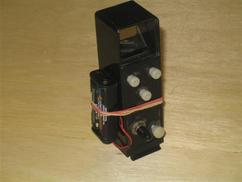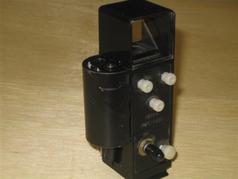|
It was one of those very clear October nights like we have sometimes. Not too cold. No Moon in the sky. The neighbor's outside lights were not on for a change. Conditions were about as good as it gets here for observing in the yard. I decided to haul out the 8-inch dobsonian and check out some of the many wonderful deep sky objects visible this time of year. I carried the OTA, base, observing chair and a couple of eyepieces out the basement door and set up between the retaining walls. I plopped in a low power eyepiece and turned on the Rigel QuickFinder. Hmmm, no red circles visible in the QuickFinder. The battery must have given up. I removed the finder from it's base and took the coin shaped battery out and tested it to be sure. Almost no voltage. Time for a replacement. .This type of unity finder uses a CR 2032 3-volt battery and is rather common on many electronic devices these days. These batteries usually sell for $2.50-$3.00. Normally I have an extra one or two in my parts drawer marked “Batteries and Holders”. I looked in the drawer. There were a bunch of AAAs, AAs and Ds but no 2032s. Drat!. But wait, there was a new holder that would hold two AAAs. It only took a minute to drill a hole in the body of the QuickFinder and push the wires of the battery holder through. It took a couple more minutes with a soldering iron to attach the lead wires. I temporarily attached the battery holder to the QuickFinder with some small rubber bands and soon I was outside observing. As the night went on I started thinking about how much more reserve power two AAAs had over that thin little 2032. Also, how much cheaper the AAAs were, too. Looked to me like I needed to make a more permanent change for battery power. And more finished look would be nice. The next day I trimmed the wires and glued the battery holder to the QuickFinder body. I cut a small piece of PVC pipe and fashioned a battery cover. After painting it black to sort of match the QuickFinder I attached it with a small amount Goop (one of my favorite adhesives). Here you can see a photo of the cobbled up version of the battery pack and another photo of the “finished” version. This is an easy project and something I probably should have done years ago. The small battery pack only adds a couple of ounces of weight to the scope and causes no balance problems.
In full disclosure I have seen a battery pack being sold online by ScopeStuff for about $14. So the idea is not original. But my version cost about the same as a new 2032 battery would and I didn't have to burn any gas to go get a new battery. I'm happy with this simple little modification.
11 Comments
4/14/2023 03:45:50 am
That was really a great Article. Thanks for sharing information and continue doing this.
Reply
4/29/2023 05:13:26 am
I like your blog very much keep doing this kind of writing.
Reply
7/6/2023 05:30:54 am
The 'Star Stuff' blog post by Terry Alford on Burgess Optical's website addresses a battery fix for the Rigel Quickfinder. This informative article provides practical guidance for resolving battery-related issues with this device. Attention to detail and troubleshooting techniques can help users extend the life and functionality of their equipment. It's great to see Terry Alford sharing valuable insights and solutions for fellow astronomy enthusiasts.
Reply
8/29/2023 11:41:19 am
I like your blog very much keep doing this kind of writing.
Reply
9/27/2023 09:08:47 am
Such a comprehensive description of the subject. Had a great time reading this article.
Reply
9/28/2023 09:22:31 am
I was very happy to discover this great site. I just have to thank you for your time for this fantastic read!
Reply
9/29/2023 10:26:53 am
Thank you for sharing such great information. It's really helpful for me. I'm always looking for quality content and finally I found this in your post.
Reply
10/30/2023 04:03:07 am
Thanks for taking the time to discuss this, I feel strongly that love and read more on this topic.
Reply
10/30/2023 08:43:19 am
Such a comprehensive description of the subject. Had a great time reading this article.
Reply
11/9/2023 01:53:45 am
I love hearing about your stargazing adventures! It's amazing how a clear night sky can completely captivate us. I've had my fair share of battery mishaps with various gadgets while stargazing, so I feel your pain. The Rigel QuickFinder is such a handy tool, and it's a shame when the battery dies unexpectedly. Hopefully, you were still able to enjoy some celestial wonders that night.
Reply
Leave a Reply. |
About the Author:
Terry Alford has been an avid amateur astronomer since 1979. He is currently a member of two astro clubs: Bays Mountain Astronomy Club (founding member) and Bristol Astronomy Club. Since 2001 Terry has taught Astronomy Labs at East TN State University. His first ATM project was in 1979 and was an equatorial pipe mount for an 8-in reflector. His woodworking shop also turns out toys for grandkids. Archives
June 2017
Categories |



 RSS Feed
RSS Feed
